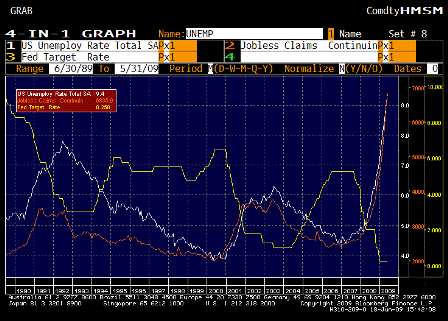On Thu, May 1, 2008 at 7:43 AM, Karim wrote:
Sorry for delayâ€â€Âwas in transit yday.
Recent information indicates that economic activity remains weak. Household and business spending has been subdued and labor markets have softened further. Financial markets remain under considerable stress, and tight credit conditions and the deepening housing contraction are likely to weigh on economic growth over the next few quarters.
Note: Economic activity not weakening further and credit conditions not tightening further, but remain ‘weak’ and ‘tight’, respectively. Housing contraction still deepening and labor market still softening.
So we remain stuck around 0% growth with tight credit conditions and a worsening labor market..
Although readings on core inflation have improved somewhat, energy and other commodity prices have increased, and some indicators of inflation expectations have risen in recent months. The Committee expects inflation to moderate in coming quarters, reflecting a projected leveling-out of energy and other commodity prices and an easing of pressures on resource utilization. Still, uncertainty about the inflation outlook remains high. It will be necessary to continue to monitor inflation developments carefully.
Note: Removed ‘inflation remains elevated’ and uncertainty about inflation has not increased, but ‘remains high’.
Feeling a little better about inflation but way too early to sound all-clear.
The substantial easing of monetary policy to date, combined with ongoing measures to foster market liquidity, should help to promote moderate growth over time and to mitigate risks to economic activity. The Committee will continue to monitor economic and financial developments and will act as needed to promote sustainable economic growth and price stability.
Note: Removed downside risks remain and ‘act in a timely manner’.
Don’t see growth falling much below the -1% to +1% range and will likely not ease at the June meeting.
I agree with former FOMC member Poole who described the statement as ‘hardly a loud and clear signal’ of a pause.
I think the Fed stands ready to ease further if fiscal action (notable in its absence in the statement) and prior eases don’t gain traction over the course of H2.
Agreed with all.
The FOMC continues to ‘trust their models’ and forecast declining inflation.
The economy continues to muddle through with GDP just north of 0, with CPI remaining north of 4% for what is adding up to a substantial period of time.
What the Fed is saying is that the current output gap/’resource utilization level’ is more than adequate to bring down cpi as per their forecasts.
This is what the mainstream would call a very high risk strategy, with the risk being that the cost of bringing down inflation later will be a lot higher than it would have been to bring it down sooner.


